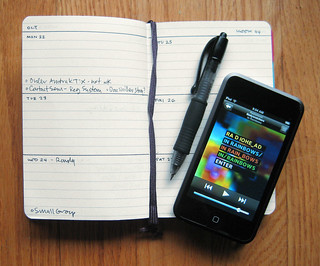 |
| Custom Moleskine Planner & iPod touch (Photo credit: Mike Rohde) |
In the last couple of entries I talked about the importance of goals, what they should include, and how to set them. Today, I am going to talk about something that goes hand in hand with goals and that is scheduling. When I talked about setting goals I mentioned that you needed to find the system that works for you when setting goals and that goes for creating a scheduling system also, and frankly I have to admit that finding a scheduling system that works for me has been difficult.
It is not scheduling itself that has been difficult but finding a system that would fit my needs. Despite all the modern electronics that are designed to make scheduling easier, I just have not found one that I like. I started by using a software program that created schedules but then realized that Microsoft Outlook basically did the same thing. While Outlook worked for a while, I hated having to getting on the computer to check my scheduling. I know that modern cell phones can also but I quickly realized that I liked having something I could look at more thoroughly than a phone.
After deciding that a software program wasn't working for me I started using an planner that my wife had laying around that was given to her by an old boss. I decided I like the idea of the planner and having it written down so I can see it all the time but this particular planner was very large ringed binder that took up a lot of room and weigh a lot and I already have enough to carry everyday so I decided to start using one of the spiral bound planners that come out every year.
While I have been using the planner on regular basis I couldn't get a system down that I really liked until I saw what one of my friends did in their planner. This person has their planner neatly organized plus has different colored sticky notes for important things and highlights important things in the planner. This gave me an idea that I have started to use in my planner.
The first thing I do is to put in all the important dates that I have coming up into the planner. For items such as important projects that are do I go through the book and put reminders in at weekly intervals that the project is coming up and then I highlight them with green if they are more than 3 weeks out, yellow of they are one or two weeks out and red for the day that they are due. This way I have regular reminders that I have something coming up so that I can be working on it and have it done before it is due.
This coming year I am making one change and that is going from a weekly planner to a daily planner due to the increased commitments and the importance of having things scheduled in a more detailed fashion. As I said before this is my system and you need to find a system that is going to work best for you so good luck.







